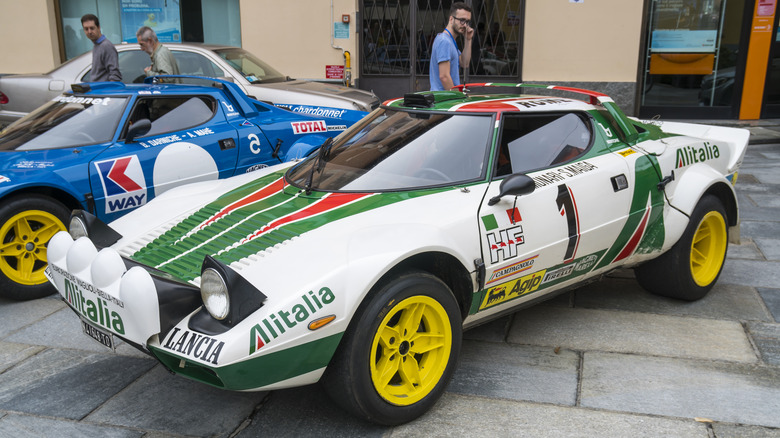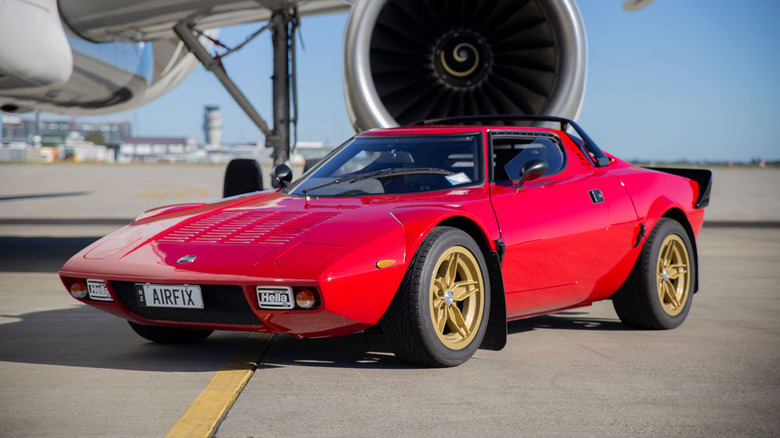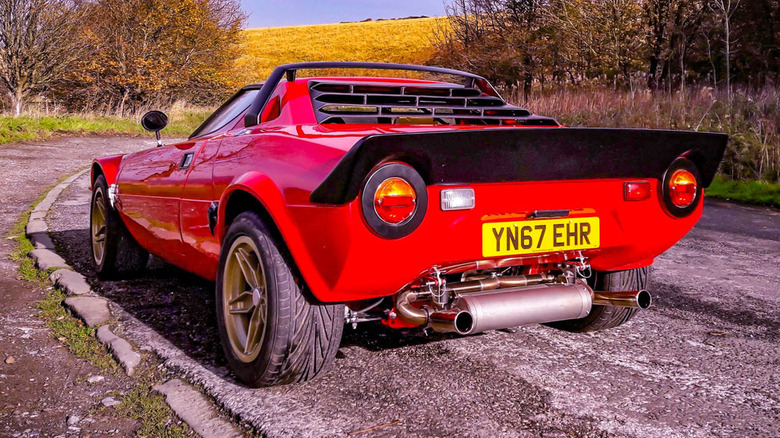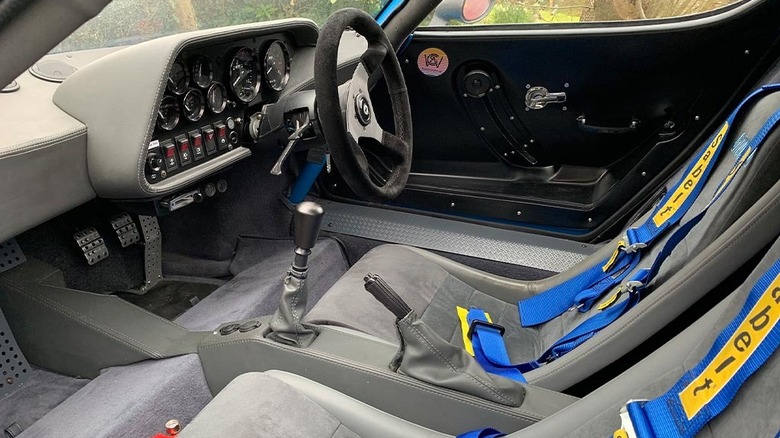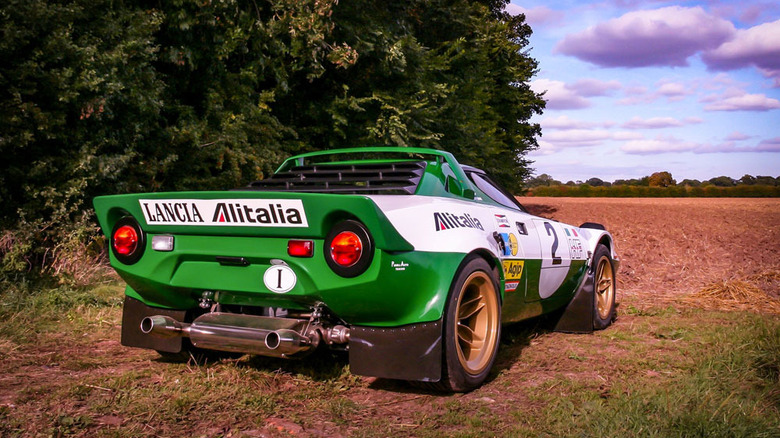Miss The Design Of Old School Rally? This Kit Car Might Be Perfect For You
The Lancia Stratos HF is one of the most iconic rally cars of all time. Designed by Marcello Gandini at Bertone and first revealed as the outlandish Zero concept car of 1970, the Stratos was produced between 1973 and 1978. It won the World Rally Championship three times in the mid-1970s, clocking up 18 individual rally wins.
This performance alone cemented the Stratos as one of the all-time greats — a position further enhanced by its memorable Alitalia racing livery (pictured above) and the lurid orange, red, and blue paint scheme and gold wheels.
Then of course there was the styling. Wedged-shaped and with a remarkably short wheelbase of just 85.8 inches, the Lancia Stratos looked unlike any other car on the road or the rally stage. It had pop-up headlights installed between a bank of four rallying spotlights, a blunt rear end with louvers covering its mid-mounted engine, and a wraparound windshield like that of an aircraft. Instead of producing its own engine, Lancia enlisted the help of fellow Italian carmaker and race team, Ferrari.
To top it all off, by basing a road car on a pre-existing race car, instead of the other way around, the Lancia Stratos can be considered the first homologation special rally car. Previously, manufacturers had turned street cars into rally specials.
As you might imagine, a Ferrari-engined, championship-winning race car like the Stratos — of which 492 road-going Stradale versions are estimated to exist — doesn't come cheap. They very rarely come up for sale, with just four sales records listed by Classic.com between 2018 and 2023. The most recent car sold for $582,500 at auction in March 2023, despite carrying a guide price of between $600,000 and $700,000.
The STR by LB Specialist Cars
But what if you could build on yourself? That's where the STR comes in, a kit car sold by British form LB Specialist Cars (formerly known as Lister Bell). The company has sold around 150 STRs over the last decade, making it somewhat rarer than the original. But because it lacks a Ferrari Dino engine — and isn't built by Lancia, of course — the STR is considerably cheaper than originals sold at auction, at about $50,000 for a kit or around $65,000 for a complete car, depending on specification.
Instead of the 3.0-liter V6 Dino engine, the STR is powered by a 3.0-liter V6 'Busso' from the Alfa Romeo 166 of the late 1990s, from which it also gets its five-speed manual transmission. It produces up to 220 horsepower, says LB Specialist Cars, and optional extras include a six-speed gearbox, Quaife differential, and an uprated clutch.
A box-fresh Stratos
Instead of taking a 1970s-era Lancia and using its chassis number to create a Stratos, the STR kit is built as a new car from scratch, ready to be registered as a new vehicle. That's why completed examples previously sold through the LB website often wear the UK's most recent vehicle license plates. For example, the above image shows an STR registered in 2017.
That said, and in the UK at least, their plates can be changed to any available example older than their build date. This means owners can fit license plates from the 1970s for a more authentic look if they so wish.
The STR kit is supplied as either left- or right-hand-drive, depending on customer preference. LB Specialist Cars says how the Alfa Romeo engines can be fitted with a plenum chamber from a Lancia Thesis, complete with the "Lancia" name cast into it, therefore giving the engine a more authentic appearance when owners pop the hood. The motor retains its original ECU and ignition immobilizer for added security, the company says, and it features an exhaust system with twin 5" stainless steel silencers.
The company uses custom-fabricated wishbones for the fully adjustable suspension, comprising a double wishbone arrangement at the front and a strut-type rear setup connected to "aircraft grade" billet alloy uprights. Front and rear anti-roll bars are fitted, along with four-pot brake calipers and 300mm ventilated rotors.
Custom interior
Inside, customers can choose how the interior looks. A recently sold example had its seats and dashboard upholstered in gray leather with matching Alcantara and a Stratos logo embroidered into the seat backs. In this case, the car is fitted with blue, FIA-compliant four-point Sabelt harnesses. Gray leather is also found on the dashboard, instrument binnacle, and transmission tunnel, while the dashboard facia was given a black powder-coated finish.
Although looking like a 1970s rally car, the STR can be fitted with a small selection of modernism conveniences. These include a heated windshield, three-speed de-mister and fan, air conditioning, and even a reversing camera — which is especially useful since the black slatted louvers almost completely block the rear screen.
Describing its car, LB says: "Our mission is to produce the STR in such a way that it pays homage to the original Lancia and therefore maintains all of the visual presence and character of the genuine Stratos but is engineered and advanced in a way better suited to this millennium."
Drives like a go-kart
What's the STR like to drive? "The compact size, light weight, and quick steering make my Stratos feel like maneuvering a go-kart," Garrick Zack, a designer at GM, told Hagerty of his STR in the summer of 2022. He added: "My kids love taking rides. The best part is the satisfaction I realized from assembling this car myself."
Zack completed his car, a gloss white example with a gray interior, in 2017 and covered 3,000 miles in it over the next five years. "It's a time machine with roots deep in the past yet capable of drawing attention today," he said. Zack initially planned to spend $50,000 on the kit car but ultimately invested approximately $100,000 in the project, which began in his mother-in-law's one-car garage — a telling sign of the Stratos' compact dimensions.
British journalist Jonny Smith drove an STR for his YouTube channel The Late Brake Show in 2021 and said: "It's got amazing front visibility because of this fighter jet cockpit," adding: "Don't get me wrong; it's raw and it's loud, but that's kind of why you buy it. And the reason why you'd buy a car like this is because you want the race-car-for-the-road feeling."
